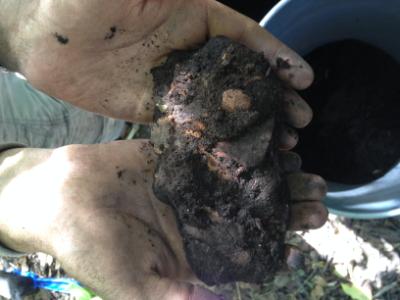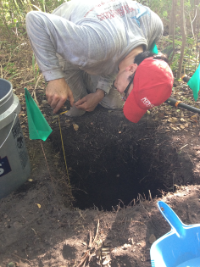Roger Sierra, a senior anthropology major in the UM College of Arts & Sciences, worked off his Thanksgiving turkey trudging through dense mangroves in Islamorada. He joined Professor and Chair of the College’s Department of Anthropology Traci Ardren for an archaeological excavation in the northern Florida Keys.
 |
| Dense faunal material unearthed in an ancient midden in the Florida Keys. |
After climbing through Brazilian pepper trees for about 20 minutes, they reached the dig site – a midden, or trash heap, where indigenous ancient people disposed of their food waste and other debris. It is roughly the size of a football field.
Ardren believes that a small village existed on the site, which is close to the water, between 600 A.D. and 1300 A.D. Even before testing and analysis, the artifacts uncovered there are providing clues about the inhabitants.
“The local people traded in canoes and ate wild food. They used shells to make tools, but did not eat many shellfish. They were not agriculturalists,” Ardren said.
The majority of items are bones – likely fish, turtles, snakes and other reptiles – along with some shells and ceramic pieces.
Many thousands of indigenous people were living in south Florida when the Spanish arrived in the early 1500s. The Calusa, who lived mostly on the Gulf Coast, exercised political domain over the area. However, Ardren said, the remains uncovered on Islamorada show little similarities with Calusa culture.
“They seem more like the prehistoric occupants of the Everglades,” she said, adding the artifacts are well preserved in the oily, organic soil of the midden.
For the Islamorada excavation, Ardren is collaborating with colleagues from the University of Georgia and the University of Oregon.
The bones will be cleaned and sent to the Georgia, where a graduate student who is a zooarchaeologist (an expert in studying animal remains) will identify them to the species level. The shells will go to the Oregon, and Ardren and her students will work on carbon dating and performing other analysis on the pottery shards.
For his senior research project, Sierra is analyzing a collection of artifacts donated to the Department of Anthropology, which were excavated from Stock Island (the island just north of Key West). “The Islamorada artifacts are extremely similar to the Stock Island artifacts,” he said.
 |
| Senior anthropology major Roger Sierra takes measurements during a dig in the Florida Keys. |
Sierra added, “The Keys are very under-researched. There are an incredible amount of sites, and you can learn so much about the people.” However, the weather, the mosquitoes and the difficulty obtaining permits are barriers to exploring this area.
Sierra will present a paper on his findings at the Society for American Archaeology meeting in San Francisco in April.
The permits to undertake the dig are valid for one year, and both Sierra and Ardren plan to return to the dig site in the coming months.
January 08, 2015

